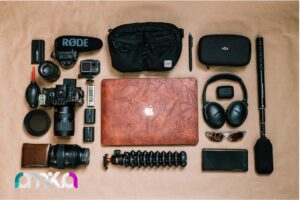5 steps in creating a logo design ✅ step by step

Category:Graphic Design
Publish Date: 2023-10-11 21:00:00
5 Steps in Creating a Logo Design
In the following sections, we will traverse through these five key steps, breaking down the intricacies, offering practical insights, and providing you with the tools you need to craft a logo that captures the essence of your brand. Whether you’re a novice designer or an experienced one seeking to refine your process, these steps will be your roadmap to logo design success. So, let’s begin this creative journey by delving into the first step: Research and Understanding. To avail yourself of our professional services in this regard, visit the Custom Logo Design Vancouver.1. Research and Understanding
The first step in fulfiling 5 steps in creating a logo design is perhaps the most critical, as it sets the foundation for the entire process. Here’s a deeper dive into the key components of this phase:- Understanding the Brand: Your brand is more than just a name; it embodies your company’s values, mission, and personality. Take the time to understand what your brand stands for. What message do you want your logo to convey? Is your brand playful and youthful, or more serious and professional? The answers of these questions will guide your design choices.
- Target Audience Analysis: To create a logo design step by step, that resonates with your audience, you need to know who they are. Who are your customers, and what are their demographics and psychographics? What visual elements appeal to them? Understanding your audience’s target is crucial in crafting a logo that speaks directly to them.
- Competitor Analysis: Study your competitors’ logos. What do their logos communicate? Identify elements that work well in your industry and those that don’t. This analysis will help you avoid clichés and ensure your logo stands out.
- Trends and Styles: Explore current design trends and styles, but don’t feel bound by them. Trends come and go, and deciding whether you want your logo to follow these trends or challenge them is essential. Striking a balance between timeless design and contemporary relevance is key.
- Legal Considerations: Intellectual property is a vital concern in logo design. Familiarize yourself with trademark laws to ensure your logo doesn’t infringe on someone else’s intellectual property. This step can save you from legal troubles down the road.

2. Conceptualization and Sketching
Once you’ve gathered insights and a clear vision of your brand with first important step of 5 steps in creating a logo design, it’s time to give shape to your ideas. Here’s what this phase involves: Brainstorming: Encourage creative thinking among your team or yourself. It’s the ideation phase where you can let your imagination run wild. Write down keywords, concepts, and associations related to your brand. This process can spark innovative ideas that may lead to a unique logo. Sketching: Start sketching rough drafts of potential logo concepts. Don’t worry about perfection at this stage; it’s about capturing your ideas on paper. These initial sketches serve as the raw material for refining your design. Simplicity: Simplicity is often the hallmark of a great logo. Aim for clarity and a clear message. A simple design is more likely to be memorable and recognizable. Versatility: Consider how your logo will adapt to different sizes and contexts. Will it work equally well on a business card and a billboard? Versatility ensures your logo remains effective across various platforms.
3. Designing and Creating
With your sketches as a guide, in logo design step by step guide, it’s time to digitally bring your logo to life. Here’s what you should focus on during this phase:- Digital Tools: Utilize graphic design software like Adobe Illustrator or Canva to create vector-based versions of your logo. These tools allow for precision and scalability.
- Color and Typography: Choose colors that resonate with your brand’s personality and select fonts that complement your design. Colors evoke emotions, so pick them thoughtfully. Typography should be legible and in line with your brand’s voice.
- Balance and Proportion: Ensure your logo elements are balanced and proportional. Pay attention to spacing, alignment, and the relationships between different elements.
- Test Variations: Create multiple logo versions to compare. Get feedback for different perspectives. It’s a big act in steps to create a custom logo.
4. Iteration and Feedback
The design process is rarely a straight line from concept to completion. It often involves revisiting and refining your work. Here’s how to approach this phase in 5 steps in creating a logo design: Feedback Loop: Share your design with stakeholders and gather constructive feedback. Be open to suggestions and critique. Use feedback as a tool for improvement. Fine-tuning: Pay attention to the smallest details. Sometimes, minor adjustments can make a significant difference in the overall impact of your logo. Time and Patience: Don’t rush the process. Take the time needed to get your logo just right. It’s better to invest more time in the design phase than to settle for a logo that doesn’t fully represent your brand. We suggest you also read this article: different types of portrait photography [elementor-template id=”19628″]
5. Finalizing and Delivering
After multiple revisions and improvements, in the very last step of 5 steps in creating a logo design, your logo is ready for the world. Here’s what you need to do in this phase:- File Formats: Prepare your logo in various formats (JPEG, PNG, SVG) for different use cases. The right file formats ensure your logo looks its best in various contexts.
- Brand Guidelines: Create a document specifying how your logo should be used. This document should include color codes, font choices, minimum size requirements, and clear rules on logo placement.
- Trademark Registration: Depending on your business and brand, consider trademarking your logo to protect your intellectual property. This legal step safeguards your logo from unauthorized use by others.

Conclusion
Now we know in 5 steps in creating a logo design, In the fast-paced business and branding world, a well-designed logo’s significance cannot be overstated. It serves as the visual anchor for your brand, the first impression that can set the tone for all future interactions with your audience. Crafting a logo isn’t just about creating an image; it’s about encapsulating the very essence of your brand in a single, memorable mark. Consider contacting Ramikar‘s Graphic Design and Logo Design Services for professional logo design services and expert assistance. With our wealth of experience and a track record of delivering exceptional logos, we can guide you through the process, ensuring that your logo meets and exceeds your expectations.FAQs
Can I design a logo myself if I’m not a graphic designer? Yes, you can design a logo, even without a graphic designer. Many online tools and software platforms offer user-friendly logo design options. How long does it typically take to create a logo from start to finish? On average, completing a logo design may take a few weeks to a couple of months. What file formats should I have for my logo design? It’s recommended to have your logo in various file formats, including JPEG, PNG, and SVG. How can I protect my logo from used or copied without permission? To protect your logo, consider trademarking it, which Provides legal protection against unauthorized use. Additionally, include clear usage guidelines in your brand guidelines document to ensure consistent and proper use by others.Recent Articles:

Video Marketing Canada: Best Strategies for 2025
7 months ago
5 min 25 sec read

Photography Services Canada: For Web & Social Media Use
8 months ago
5 min 2 sec read

Logo Design Canada: Create a Logo That Truly Stands Out
8 months ago
4 min 38 sec read
Let us help !
Related Posts
Comments
0
0
votes
Article Rating
Subscribe
Login
0 Comments
Oldest
Newest
Most Voted
Inline Feedbacks
View all comments






